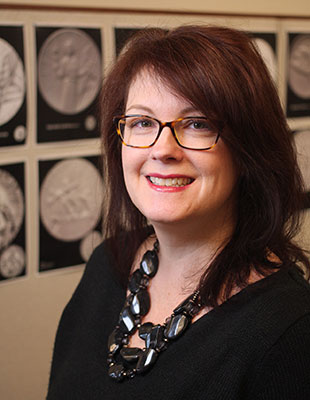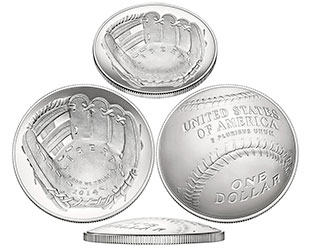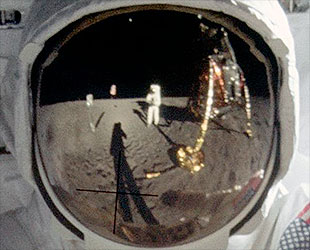May 1, 2017 – What should be depicted on the front of the United States coins that will commemorate 50 years since the first moon landing?
To answer that question, the United States Mint launched a public design competition on Monday (May 1). Interested artists have until June 29 to submit their portfolio to vie for a chance to propose a design for the coins.
As called for by Congress, the Mint will issue curved gold, silver and clad metal coins, all bearing a common design, "to recognize the 50th anniversary of the Apollo 11 mission and to honor the United States space program leading up to the first manned moon landing." Proceeds from the sale of the coins will benefit the Smithsonian's National Air and Space Museum, the Astronauts Memorial Foundation and Astronaut Scholarship Foundation.
collectSPACE spoke with April Stafford, chief of the Mint's Office of Design Management, to learn more details about the 2019 Apollo 11 50th Anniversary Commemorative Coin Design Competition.
collectSPACE (cS): Why a design competition over an in-house designer? The provision for the contest was written into the bill that authorized the commemorative coins. Was that something suggested by the Mint to Congress?
April Stafford: The Mint does not suggest or request that provisions be added to a bill. The U.S. Mint is required to administer all programs according to legislation enacted by Congress and signed into law by the President.
Accordingly, the sponsor of the Apollo 11 50th Anniversary Commemorative Coin Act added the competition provision, which lawfully requires that the Mint execute the program as so.

April Stafford, chief, U.S. Mint Office of Design Management. (Mint) |
cS: How does this design competition differ, if at all, from past competitions held by the Mint?
AS: The structure of the competition is similar to those the Mint has recently held.
During Phase One, which is open to the public from May 1 through June 29, artists will submit three to five samples from their existing portfolio, along with contact information. This can be uploaded to the Mint's website. The portfolios will be evaluated by an expert jury. From there, the jury will choose no more than 20 artists to take part in Phase Two.
What is different with this competition is that during Phase Two, finalists only need to submit a two-dimensional digital design. Recent competitions have required or suggested a three-dimensional model be part of the entry.
For this competition, a three-dimensional model will not be accepted due to the complexity of sculpting on a curved basin. Also of note, those invited to take part in Phase Two will be paid a stipend of $500.
cS: On average, how many entries have been received in prior two-phase competitions?
AS: The Mint does not disclose the number of responses for past competitions. But we have been very pleased with both the quantity and quality of the entries.
cS: Why must artists be 18 years of age or older?
AS: It is the Mint's policy that artists must be 18 years of age or older due to legal and contract requirements.
cS: What type of art samples works best for the first phase of the competition? Should it be space related?
AS: While the Mint wants to encourage as many artists as we can to participate in this competition, they do need to demonstrate certain aspects of their expertise. Things that come into play are...
the ability to convey concepts with symbolism
interpreting subject matter and conveying its theme
the ability to render figures, portraits or landscapes with the right perspective and scale... It becomes interesting when you're creating art for a space that can literally be held in your hands like coins are.
cS: What is special about the four coins in the Apollo 11 50th anniversary commemorative program?

The Apollo 11 50th anniversary coins will be domed, or curved, like the 2014 National Baseball Hall of Fame coins. (U.S. Mint) |
AS: All four Apollo 11 coins are curved, which, given the subject matter, will make for very engaging artistic designs. Also special is that this is the first time in recent years that a U.S. Mint commemorative coin program has more than three coins.
Finally, the fourth coin in this program is a 5 ounce version. The U.S. Mint has never produced and offered a curved 5 ounce coin in its history, so that will add to the excitement as well.
cS: What makes for a good design for this Apollo 11 50th anniversary commemorative coin competition? Space can be very wide topic — are there particular aspects to space exploration history that artists should limit themselves to?
AS: For Phase Two, where the finalists are submitting the actual design of the coin's obverse, the judging panel will look at several things:
The overall quality in conveying the subject matter — in this case the U.S. space program leading up to the first manned moon landing.
Appropriate use of symbolism and level of detail for the scale and material of coins and medals.
Other things such as the effective incorporation of the required text, design sense, composition, clarity and balance of space will also come into play.
cS: The U.S. Mint advises on the competition website that artists should resist basing their designs on photos. Since NASA imagery (e.g. the photos taken on the moon) is in the public domain, can they be used for inspiration?
AS: The design of the coins' obverse (heads side) should be emblematic of the United States space program leading up to the first manned moon landing.
Inspiration for this program, and all coin designs for that matter, can be taken from photos, video, audio, personal memories or anything that inspires an artist. However, the design must be the artist's original work and not be based on pre-existing work, whether it is in the public domain or not.
It's also important to note that the designs may not include the name or depiction of any living person – including an astronaut – even with permission.
cS: Will the Mint be sharing publicly the (up to) 20 artists who are selected for phase two?
AS: No, we will not be publicly sharing the artists who are selected for Phase Two.
cS: Will the Mint be sharing publicly the designs submitted by the (up to) 20 finalists?
AS: The U.S. Mint will not be sharing publicly the designs submitted by the finalists. However, the legislation for this competition requires that the designs be reviewed by the two federal advisory committees — the Citizens Coinage Advisory Committee (CCAC) and the U.S. Commission on Fine Arts. As these committees hold public meetings, the designs will be released to the public on the date of those meetings.
The submissions will be released anonymously; the names of the submitting artists will not be released.
cS: The jury comprises members of the CCAC and Fine Arts Commission, as well as a U.S. Mint representative. Notably absent is someone from NASA or someone who has direct knowledge of space history. Will there be such a person or persons who will assist the Mint and/or jury to ensure historical accuracy?
AS: Yes, there will be subject matter experts available to advise the jury on historical and technical accuracy during the judging process. In fact, the legislation stipulates the Mint work with the Administrator of NASA or a designee on the reverse for this coin. The Mint plans to leverage this expertise also for a review of the obverse design.

The iconic image of Buzz Aldrin's spacesuit helmet visor will serve as the design for the reverse of commemorative coins recognizing the 50th anniversary of Apollo 11, as Congress directed. (NASA) |
cS: Will the Mint be waiting to see the winner of the design competition before designing the reverse of the coin to ensure the two match, aesthetically?
AS: No, as soon as the legislation was signed into law earlier this year, the Mint reached out to NASA to obtain a high resolution version of the famous "Buzz Aldrin on the Moon" photograph taken on July 20, 1969. Mint sculptor-engravers were tasked with generating candidate designs that would work across all four coins in the program. We have shared these designs with NASA to ensure technical and historical accuracy.
We're excited to bring these candidates to the CCAC and U.S. Commission of Fine Arts to finalize the designs.
For more details, see the 2019 Apollo 11 50th Anniversary Commemorative Coin Design Competition website.
